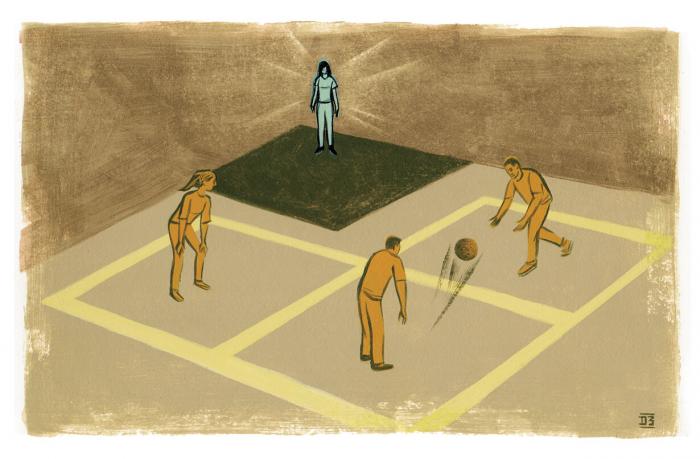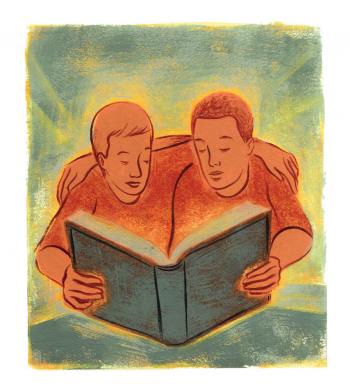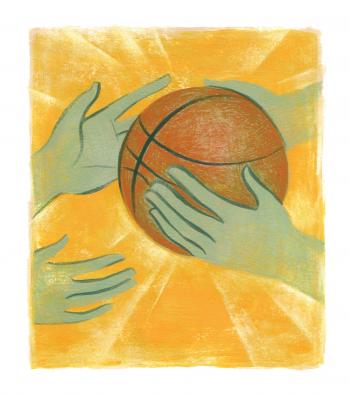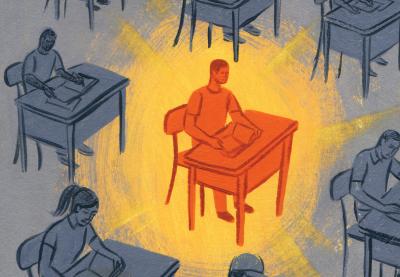Laughing and snapping pictures, students make their way around tables in the noisy, crowded rooms at Margarita's Mexican Grill in Santa Clarita, Calif. They stop to talk to friends, as well as the teachers and administrators who have joined them for dinner this Wednesday evening. The 40 or so students, from junior and senior high schools in the William S. Hart Union High School District, are participants in a program called "Yes I Can."
J.J., a sophomore with brown hair falling over his ears, stops to hug the district's speech and language specialist. He pauses to mug for a photo with Elliot, another sophomore, whose smile stretches across his face. Spying other friends at tables across the room, J.J. takes off. "I'm loving this!" he calls out.
The dinner at Margarita's helps raise funds for the students' year-end rock concert. But the outing has another purpose — to give students with and without disabilities a chance to have a good time together. About half the students here tonight have a significant disability that in the past has isolated them, socially and sometimes physically, from their peers. J.J. has a form of autism called Asperger's syndrome, sometimes more problematic because it is unnoticeable in appearance.
Emily Iland is one of many parents here tonight, laughing and talking among themselves. Iland's son Tom, now a college student, also has Asperger's syndrome. In 2001, hoping to alleviate the harassment and social isolation Tom had experienced, Iland helped to bring the Yes I Can program to the Hart district.
Iland says parents understand the effects of social isolation at school — the often total absence of phone calls from classmates and activities with peers — in ways that teachers often cannot. At gatherings like the one at Margarita's, she says, "It's such a relief to see your kid happy, accepted, part of the group."

The Causes and the Costs
Social isolation and the harassment of students with disabilities are closely related problems that occur in schools throughout the country. Often, both problems begin in middle school, as children's elementary school friends fade from the picture.
Developmentally, says Martha Snell, a professor of education at the University of Virginia, middle school students possess the tendency to mock differences, whether racial, economic or ability-related. As a result, Snell says, "you can predict that a person with a disability will be made fun of unless there are some things in those kids' lives to counter that, to say this is not a good thing."
Social isolation and harassment can feed each other — without meaningful interaction with students with disabilities, other students are more likely to make hurtful remarks based on stereotypes. In return, faced with the threat of being teased, students with disabilities are less likely to assert themselves. Without deliberate interventions, the cycle can be never-ending — sometimes with extreme personal and academic consequences.
If not addressed, social isolation can deprive students of important social skills needed for post-secondary school, jobs and happy lives — skills most other students pick up naturally as they enjoy give-and-take with peers. And harassment and loneliness undoubtedly contribute to a dropout rate that is double that of students without disabilities.
Students without disabilities lose out, too, when their peers remain isolated: They become more likely to absorb the stereotypes and fears about people with disabilities that pervade American society, and they miss opportunities to learn new perspectives from people with different life experiences.
Barbara Trader is the executive director of TASH, an international disability advocacy association at the forefront of social inclusion efforts. Trader believes that one of the most destructive attitudes in society is that people with disabilities are somehow less — less human, less likely to be aware of what's going on around them, less sensitive.
"Until a person establishes a personal relationship with another person who has a disability, they don't understand how wrong that is, how mean-spirited, how prejudicial," Trader says.
Inclusion Makes the Difference

Many schools use inclusive classrooms—the placement of students with disabilities in general education classes — as a tool for integrating students into the school community. This is a good first step. Fewer schools, though, offer social inclusion efforts in or beyond the classroom.
Yet disability experts agree that informal interaction between students with and without disabilities is a necessary antidote to isolation and teasing. Some school districts are taking heed, creating programs so students with and without disabilities can spend casual time together as peers, sharing common interests and socializing.
Called social inclusion programs, these efforts vary in design and structure, but the most successful programs reflect best practices identified by disability experts:
- opportunities for fun activities in relaxed settings outside of the classroom;
- one-on-one relationships between students with and without disabilities, based on equality and common interests;
- school-wide effort to promote respect for differences among all students — not a project relegated only to one class;
- expectations that young people with disabilities will express everything they need to engage in activities and that their needs will be met;
- discussions about disabilities that dispel myths and stereotypes;
- continuation of relationships/program involvement for a full school year.
In a twist that seems equally ironic and hopeful, young teens — the age group most likely to bully mercilessly — often seem the most enthusiastic about participating in social inclusion programs.
At Palmetto Middle School in Williamston, S.C., for example, teacher Jennifer Dorriety introduced an inclusion program called Gym Friends last fall.
Seventy-five students volunteered — far more than she had expected. Fifty more volunteers have since asked to be included.
Recently, one of the 6th-grade participants encountered a group of 8th graders making snide remarks to a student with a disability in the boys' bathroom. The 6th grader put a quick stop to it by saying, "You wouldn't treat your friends that way, and I don't like when you treat my friend that way." Then he walked the student back to Dorriety's classroom and explained what had happened.
Snell, the education professor, isn't surprised by the response of students at Palmetto. She says intervention with students in middle school can affect rapid change — especially when it involves doing things that are novel and fun. A positive experience, which Snell calls "the biggest antidote to bullying," can cause middle school students to cease bullying and quickly turn into advocates, she says. "And from then on," she adds with a laugh, "they can almost get into fights as defenders."
Social inclusion programs can have spillover effects, too, slowly changing attitudes not just among participating students, but challenging the climate of the entire school. Aileen, a senior at St. Paul, Minn.'s private Cretin-Derham Hall, participates in the school's Friendship Club program.
Her experience has made her reflect on peers' use of words like "retarded" as commonplace put-downs.
"At one point in life, I threw it around, as well," Aileen says. "But now, (with) my friends, I say, 'Hey, use a different word. You're taking something that's bothersome to you and putting a word to it that describes people. And they're my friends.'"
One Passionate Teacher

People with disabilities have experienced a long history of exclusion from public schools. Prior to 1975, states could lawfully refuse to serve students with disabilities. That year, when Congress passed the first law guaranteeing an education to students with disabilities, an estimated one million students were being left out of the public education system.
The landmark law, now known as the Individuals with Disabilities Act, mandates a free and appropriate public education for students with disabilities, with an emphasis on inclusive classrooms.
Yet in 2000, a report to Congress showed that less than half of all students with disabilities experienced inclusive classroom settings for 80 percent or more of each school day. The rates for students with significant disabilities were much lower.
Experts say the No Child Left Behind Act's emphasis on testing has compounded the classroom isolation. Expensive testing means social programs are put on the back burner in many schools.
"Right now, no one is asking the question, 'Does this child have a friend?'" says Brian Abery, who helped developed the Yes I Can curriculum. "Research clearly suggests that for kids with significant disabilities, an ability to develop lasting friendships and a close circle of support has a lot more to do with their success later in life than how well they can balance a checkbook." In this environment, how can social inclusion programs get off the ground? Abery advises starting small and being flexible. If one passionate teacher gains the support of administrators, he says, "the program will sell itself."
